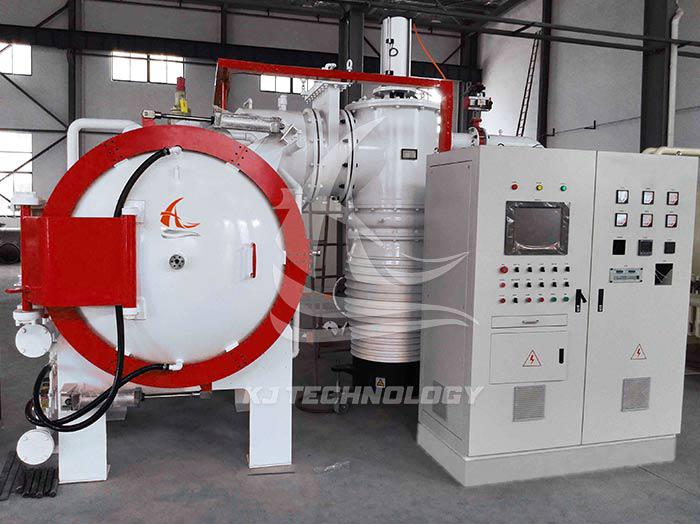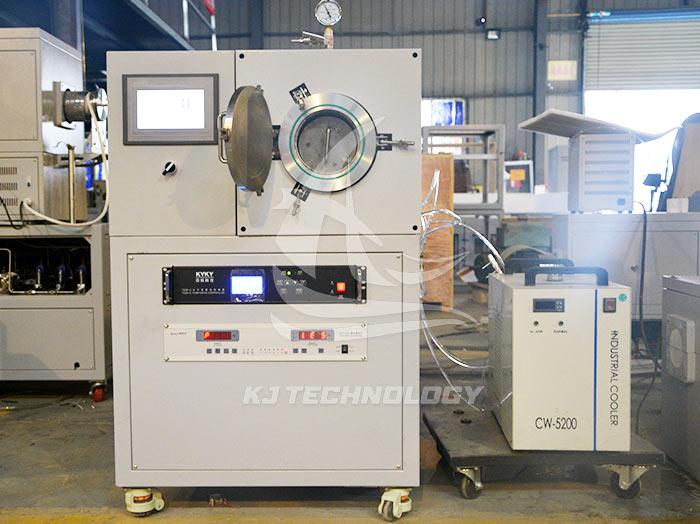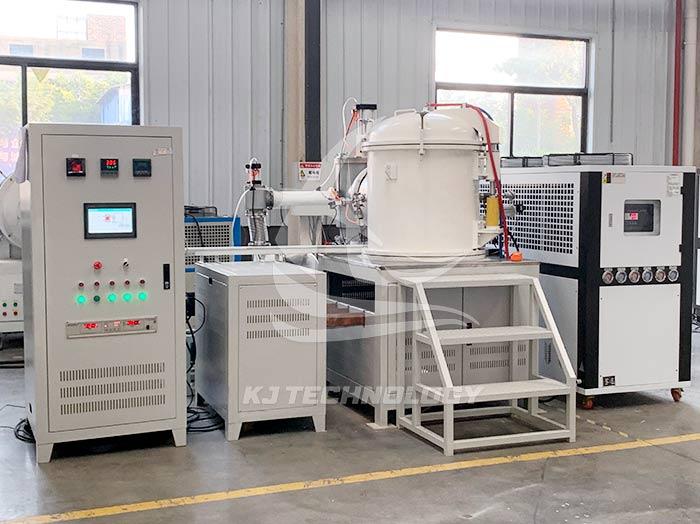Precautions for operating vacuum heat treatment atmosphere electric furnace
 06-30-2025 Author: KJ technology
06-30-2025 Author: KJ technology
The operation of vacuum heat treatment atmosphere electric furnace must strictly follow safety regulations and process requirements to ensure stable operation of equipment, compliance with product quality standards, and personnel safety. The following are key precautions during the operation process, covering equipment inspection, process control, safety protection, and maintenance:
1. Preparation before operation
Equipment inspection
Vacuum system: Check the oil level and quality of the vacuum pump (clear and free of impurities), and confirm that there is no leakage in the pump body; Check that the vacuum valves (such as front stage valves and bypass valves) are flexible in opening and closing, and that the sealing rings are free of aging cracks.
Heating system: Check whether the heating elements (such as graphite tubes and molybdenum wires) are intact, without any breakage or short circuit phenomenon; Confirm that the thermocouple (temperature measuring element) is securely installed and at an appropriate distance from the workpiece (usually 5-10mm).
Atmosphere system: Check whether the gas pipeline connection is tight and there is no leakage; Confirm that the calibration of gas flow meters and pressure gauges is valid, and the range matches the process requirements (such as methane flow rate of 0.5-2 L/min for carburizing).
Cooling system: Check the water level and temperature of the chiller (usually 20-30 ℃), and confirm that the water circuit is not blocked; The gas quenching furnace needs to check the pressure of the gas cylinder (such as argon gas cylinder pressure ≥ 5 MPa).
Safety device: Test whether the functions of over temperature alarm, over voltage protection, emergency stop button, etc. are normal; Confirm that the fire extinguishing device (such as CO ₂ fire extinguisher) is within its validity period.
Workpiece preparation
Cleanliness: The surface of the workpiece must be free of oil stains, rust, and oxide scale, otherwise it needs to be pre treated by sandblasting, acid washing, or solvent cleaning.
Furnace loading method: Avoid overlapping or obstructing workpieces to ensure uniform heating; Thin walled parts (such as blades) need to be fixed with specialized fixtures to prevent deformation.
Material compatibility: Confirm that the workpiece material matches the process gas (such as disabling nitrogen at high temperatures for titanium alloys to avoid the formation of TiN brittle layers).
Confirmation of process parameters
According to the material type (such as high-speed steel, mold steel) and performance requirements (such as hardness, wear resistance), set the heating temperature, holding time, heating rate (generally ≤ 10 ℃/min), and cooling method (such as gas quenching, oil quenching).
The processes of carburizing and nitriding require advance calculation of gas flow rate and time to ensure that the depth and concentration of the carburizing layer meet the standards (such as carburizing layer depth of 0.5-1.5mm, surface carbon content of 0.8% -1.0%).
2. Key control points during operation
Vacuum pumping stage
Rough and fine pumping: First, turn on the mechanical pump to pump below 10 Pa, and then start the diffusion pump (or molecular pump) to pump to the required vacuum degree for the process (such as carburizing process requiring ≤ 10 ⁻ ² Pa).
Leakage inspection: If the vacuum degree drops too quickly (such as from 10 ⁻³ Pa to 10 ⁻¹ Pa within 10 minutes), immediately stop the machine to check the sealing of the furnace body (such as observation windows and flange connections).
Heating and insulation stage
Temperature uniformity: Real time monitoring of furnace temperature through thermocouples to ensure a temperature difference of ≤ ± 5 ℃ (below 1200 ℃); If the temperature fluctuates too much, adjust the heating power or check the position of the thermocouple.
Atmosphere control:
Carburizing process: After heating to 900-950 ℃, methane (flow rate 0.5-2 L/min) and hydrogen (flow rate 1-5 L/min) are introduced, and the furnace pressure is maintained at 10-100 Pa.
Nitriding process: Ammonia gas (flow rate 0.3-1 L/min) is introduced at 500-600 ℃, with a pressure of 10-50 Pa, and the exhaust gas composition is regularly tested (such as NH3 decomposition rate ≥ 80%).
Safety monitoring: If the hydrogen concentration exceeds 4% (explosive limit), immediately shut down and ventilate.
cooling stage
Gas quenching cooling: During high-pressure gas quenching (pressure 5-10 bar), slowly fill argon gas to 0.1 MPa first, and then gradually increase the pressure to the process pressure to avoid cracking of the workpiece due to thermal stress.
Oil quenching cooling: It is necessary to confirm the temperature of the oil tank (usually 60-80 ℃) and the oil level. After the workpiece is filled with oil, the oil should be stirred to accelerate the uniformity of cooling.
Cooling rate control: By adjusting the gas flow rate or oil temperature, ensure that the cooling rate meets the material requirements (such as high-speed steel requiring ≥ 50 ℃/min to avoid incomplete martensitic transformation).
3. Safety protection measures
Personal Protection
Operators are required to wear protective goggles, heat-resistant gloves, gas masks (when handling toxic gases such as CO), and anti-static work clothes.
Do not wear synthetic fiber clothing to prevent static electricity from causing explosions.
Gas safety
Hydrogen usage: Hydrogen cylinders should be kept away from sources of ignition and stored in well ventilated areas; The hydrogen pipeline needs to be grounded to prevent static electricity accumulation.
Toxic gas treatment: Exhaust gases such as CO and ammonia need to be treated through combustion or chemical absorption devices and discharged after meeting standards.
Gas leakage emergency: equipped with gas leakage detectors. Once an alarm is triggered, the machine must be immediately shut down, the gas source must be turned off, and personnel must be evacuated.
high temperature protection
The surface temperature of the furnace body may exceed 100 ℃, and warning signs should be set up to prohibit touching.
When loading and unloading workpieces, special tools (such as long handled clamps) should be used to avoid direct contact with high-temperature workpieces.
4. Post operation maintenance
Equipment cleaning
Clean the residue inside the furnace after each use (such as carbon deposits and oxide scales) to prevent contamination of subsequent workpieces.
Regularly replace the vacuum pump oil (usually 500-1000 hours) and clean the oil circuit filter.
Calibration and Maintenance
Calibrate thermocouples, pressure gauges, flow meters, and other instruments quarterly to ensure measurement accuracy.
Every year, professional personnel inspect key components such as heating elements and vacuum valves, and replace aging sealing rings.
Record and Trace
Detailed records of process parameters (temperature, time, gas flow rate), equipment status, and workpiece quality data for each operation.
Establish equipment maintenance records for easy problem tracing and improvement.
5. Common problems and emergency response
Insufficient vacuum degree
Reason: Leakage of furnace body, malfunction of vacuum pump, excessive gas flow.
Solution: Stop the machine to check the sealing ring and vacuum pump oil level, and adjust the gas flow rate to meet the process requirements.
Abnormal temperature
Reason: thermocouple damage, heating element open circuit, control cabinet malfunction.
Solution: Replace the thermocouple or heating element, restart the control cabinet and recalibrate the temperature.
Gas supply interruption
Reason: Insufficient gas cylinder pressure, pipeline blockage, flow meter malfunction.
Solution: Replace the gas cylinder, clear the pipeline, or repair the flow meter. If the process is interrupted, it is necessary to re evacuate and replenish the air.
Workpiece deformation or cracking
Reason: Excessive cooling rate, improper furnace loading method, and excessive internal stress in the material.
Solution: Adjust cooling parameters (such as reducing gas quenching pressure), optimize furnace loading methods, and pre treat high stress materials (such as stress relief annealing).








